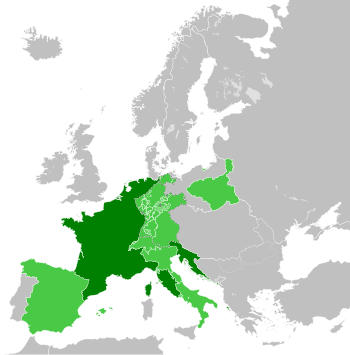First French Empire
The First French Empire[1][2], also known as the Greater French Empire or Napoleonic Empire, was the empire of Napoleon I of France. It was the main power of most of continental Europe during the early 19th century.
Empire Français | |
|---|---|
| 1804–1814, 1815 | |
| Anthem: | |
 The French First Empire in 1812 (green), with its client states in light green | |
| Capital | Paris |
| Common languages | French |
| Religion | Roman Catholicism |
| Government | Monarchy |
| Emperor | |
• 1804–1814/1815 | Napoleon I |
• 1815 | Napoleon II[4] |
| Legislature | Parliament |
| Senate | |
| Corps législatif | |
| Historical era | Napoleonic Wars |
• | 18 May 1804 |
• Coronation of Napoleon I | 2 December 1804 |
| 7 July 1807 | |
| 24 June 1812 | |
| 11 April 1814 | |
• | 20 March – 7 July 1815 |
| Area | |
| 1812[5] | Lua error in Module:Convert at line 1850: attempt to index local 'en_value' (a nil value). |
| Population | |
• 1812 | 96,472,000 |
| Currency | French Franc |
| ISO 3166 code | FR |
| Today part of | |
History
Napoleon became Emperor of the French on 18 May 1804. He was crowned Emperor on 2 December 1804. This ended the time of the French Consulate. He won early military victories in the War of the Third Coalition against Austria, Prussia, Russia, Portugal, and allied nations. The Treaty of Tilsit in July 1807 ended two years of bloodshed on the European continent.
The next wars, known as the Napoleonic Wars, grew France over much of Western Europe and into Poland. At its biggest in 1812, the French Empire had 130 départements, ruled over 90 million people, and had a large military in Germany, Italy, Spain, and the Duchy of Warsaw.[6] The introduction of the Napoleonic Code through the continent increased legal equality, made jury systems, and legalized divorce.[7] Napoleon placed relatives on the thrones of several European countries. He gave many noble titles, most of which went away after the empire fell.
Napoleon abdicated in 11 April 1814. The Empire was briefly brought back during the Hundred Days period in 1815 until Napoleon's defeat at the Battle of Waterloo. It was followed by the Bourbon Restoration monarchy of the House of Bourbon. Louis XVIII of France became the new ruler.
First French Empire Media
Le Chant du Depart, anthem of the First French Empire. (Instrumental)
The Battle of Austerlitz, 2nd December 1805, by François Gérard
The Arc de Triomphe, ordered by Napoleon in honour of the Grande Armée, is one of several landmarks whose construction was started in Paris during the First French Empire.
Napoleon reviewing the Imperial Guard before the Battle of Jena, 1806
Aftermath of the Battle of Eylau, 1807
Napoleon demanded that Alexander I of Russia and Frederick William III of Prussia meet him at Tilsit in July 1807.
Napoleon and his staff during the War of the Sixth Coalition, by Jean-Louis-Ernest Meissonier
References
- ↑ 1.0 1.1 But still domestically styled as French Republic until 1808: compare the French franc minted in 1808 [1] and in 1809 [2], as well as Article 1 of the Constitution of the Year XII, which reads in English "The Government of the Republic is vested in an Emperor, who takes the title of Emperor of the French."
- ↑ 2.0 2.1 The official bulletin of laws of the French Empire
- ↑ Le Chant du Départ, Fondation Napoléon, 2008, retrieved 16 May 2012
- ↑ According to his father's will only. Between 23 June and 7 July France was held by a Commission of Government of five members, which never summoned Napoleon II as emperor in any official act, and no regent was ever appointed while waiting the return of the king. [3]
- ↑ Rein Taagepera (September 1997). "Expansion and Contraction Patterns of Large Polities: Context for Russia". International Studies Quarterly. 41 (3): 501. doi:10.1111/0020-8833.00053. JSTOR 2600793. Retrieved 2021-08-20.
- ↑ Martyn Lyons, Napoleon Bonaparte and the Legacy of the French Revolution. p. 232
- ↑ Martyn Lyons p. 234-236
